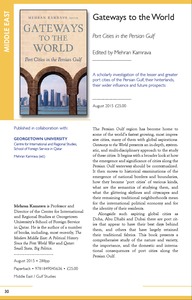The emerging urban landscape in the southern Persian Gulf
Salama, Ashraf M; Kamrava, Mehran, ed. (2016) The emerging urban landscape in the southern Persian Gulf. In: Gateways to the World. C Hurst & Co Publishers Ltd, London, UK, pp. 121-156. ISBN 9781849045636
![Gateways_to_the_world_port_Cities_Persian_Gulf_Book_Announcement-Hurst_Catalogue [thumbnail of Gateways_to_the_world_port_Cities_Persian_Gulf_Book_Announcement-Hurst_Catalogue]](https://strathprints.strath.ac.uk/52683/1.hassmallThumbnailVersion/Gateways_to_the_world_port_Cities_Persian_Gulf_Book_Announcement_Hurst_Catalogue.png)  Preview |
Image.
Filename: Gateways_to_the_world_port_Cities_Persian_Gulf_Book_Announcement_Hurst_Catalogue.png
Accepted Author Manuscript Download (317kB)| Preview |
Abstract
This chapter examines the state of contemporary urban environments in the Gulf, and aims to explore the phenomenon of global flows and their impact on regional urbanism and architecture. The key characteristics of contemporary urbanism are identified through a critical analysis of three main aspects. These include the development of “bespoke” infrastructure to accommodate “global flows;” the decentralizing of urban governance and decision-making to entice investment in the urban environment; and the resulting chaotic but emotionally detached urban scene characterized by exclusive development projects, high-rise agglomerations, and social segregation. As architectural innovation is an integral component of the urban landscape of emerging cities in the Gulf, I classify contemporary endeavors into two categories: the overt and subliminal agenda to construct an iconic and cultural architectural identity coupled with the resultant evolution of “multiple modernities” as reflected in a strikingly vibrant plurality of trends. Case examples demonstrate the rush to brand art and culture into a comprehensive and admired identity supported by a rigid agenda to encourage and sustain educational and environmental awareness. Based on the results of in-depth discussion and analysis of these issues the chapter concludes with key challenges relevant to the competitive nature of various emerging cities in the Persian Gulf.
-
-
Item type: Book Section ID code: 52683 Dates: DateEvent1 October 2016Published15 October 2015AcceptedNotes: Published in collaboration with Georgetown University: CIRS- Center for International and Regional Studies, School of Foreign Service in Qatar Subjects: Fine Arts > Architecture Department: Faculty of Engineering > Architecture Depositing user: Pure Administrator Date deposited: 16 Apr 2015 09:02 Last modified: 11 Nov 2024 15:00 Related URLs: URI: https://strathprints.strath.ac.uk/id/eprint/52683
 Tools
Tools Tools
Tools





